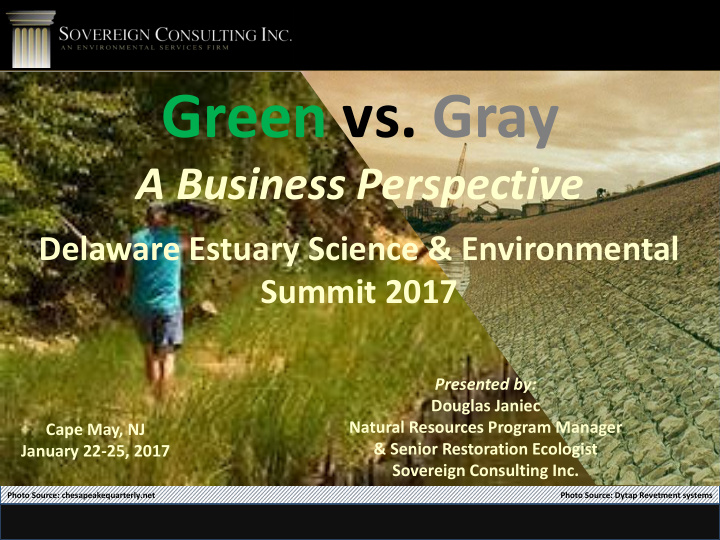



Green vs. Gray A Business Perspective Delaware Estuary Science & Environmental Summit 2017 Presented by: Douglas Janiec Natural Resources Program Manager Cape May, NJ & Senior Restoration Ecologist January 22-25, 2017 Sovereign Consulting Inc. Photo Source: chesapeakequarterly.net Photo Source: Dytap Revetment systems
What is the Nexus for this Talk? • Various entities working with coastal resilience and living shoreline initiatives have identified a need for outreach and training of marine contractors and consultants (e.g., DNREC, NJDEP, PDE, CIB, NWF, MARCO, etc.). • To meet this need, training workshops have occurred and continue to occur in the region . • At these workshop, reoccurring comment: “Show me how to make money doing this, and I will consider doing it.”
Where is the Market? Bayside and Coastal Shorelines Rural Areas Developed Areas Remote Areas Accessible Areas Publicly Owned Privately Owned (Government) (Residential, Commercial, Industrial) • Rural & Accessible = Ecosystem Services potential ~ $$$ • Large Federal and State projects are typically run through pre- existing MSA/IDIQ type contracts
Risks, Unknowns, Challenges • It has to consistently work • It has to be affordable • It has to be permittable • It has to be sellable
Why Incorporate “Green” Into A Business Model? • It is the “Buzz,” and tied to an issue that isn’t going away • It is viewed favorably by the regulatory community • Money is being committed to it from many sources • It is sellable • You do not have to change or abandon what you are currently doing; this is an additive service And wait for it wait for it • It benefits the environment! • And your reputation!
Lesson Learned #1: Selling the Right Perception It should not be Green vs. Gray , but Green & Gray • Avoid viewing the two as competition • Consider it as another tool in the toolbox • Green + Gray = Hybrid
Lesson Learned #2: The Missing Link • The infrastructure is there: • Contractors (e.g., equipment and laborers) • Engineers/LAs (e.g., design skills) • What may be missing?: • Restoration Ecology/Ecologists (i.e., the natural science element)? • Experience and developed skill sets?
Lesson Learned #2: The Missing Link • The infrastructure is there: • Restoration Ecology/Ecologists (i.e., the natural science element)? • Experience and developed skill sets? • What may be missing?: • Contractors (e.g., equipment and laborers) • Engineers/LAs (e.g., design skills)
Lesson Learned #3: Branding - Rebranding 1. ID the market regions 2. ID the circles in the identified regions involved in LSs 3. Become Fundamental Branding Concept visible, involved, Keep Your Branding Simple (FBC #2) and create associations (be missed) 4. Have clients and colleagues turn to you and recommend you In NRs, You Must Connect With Keeping It Real Builds Trust Your Client’s Interests
Lesson Learned #4: Know Your Private Sector Client Profile • General technical ignorance (often limited to the internet) • Heightened monetary sensitivity • Often reluctant to make commitment or decisions • Often do not know what they want (but often do know what they don’t want or don’t like) • They like to see expertise, The private sector can be challenging, confidence, and honesty (trust) but it can also provide the greatest job satisfaction.
Lesson Learned #5: Private Sector Keys to Success • Clearly identify project issues, drivers, and goals • Identify potential partners ( e.g., NEP, agencies, other private entities ) • Be prepared for outreach and education ( workshops/charrettes/private lectures ) • Keep client engaged ( decision making, implementation, citizen monitoring, PR ) • Know your local politics • Instill confidence ( be the anchor ) • Show examples and picture, present the vision • Know when to walk away
Help Them Picture Or Create The Vision Thank you LSS, Inc.
Lesson Learned #6: Know Your Costs (e.g., unit rates, ranges, min/max values) Conventional LSs Hybrids LSs (structural) • Center for Coastal Resources Management - VIMS $ 50 - $100 $150 - $ 500 • Chesapeake Bay Foundation $ 50 - $100 $150 - $1,200 • Partnership for the DE Est. (Brochure) $100 - $225 $250 - $1,000 PDE Brochure Breakwaters/Bulkheads $450 - $1,500 Wave Energy Based Ranges Low Moderate High $50 - $250 $175 - $600 $350 - $1,000 Have An Idea Of Cost Relations Between Tactics *Estimated ranges do not include studies, design, or permitting costs.
Lesson Learned #7: Remind Client That Energy Attenuation & Living Shorelines Come In Many Shapes & Sizes
Lesson Learned #7: Remind Client That Energy Attenuation & Living Shorelines Come In Many Shapes & Sizes
Lesson Learned #8: Know Your Private Sector Pitfalls • To many tactics, • Not knowing when to …… master of none walk away Or None • Technical Team Expertise • Strategic service offering • Internal (to start with) • External • Small menu vs. large • Blend menu • Stay out of Lal-la-land • Menu growth • Develop real expectations • “I can do anything” • Avoid client sticker- syndrome shock
Lesson Learned #9: Show Value; Return On Investment Examples: • Sediment Retention • Carbon Retention • Nutrients Retention (shellfish) • Commercial Fisheries • Flood Waters Retention • Recreation • Other Ecosystem Services • Resilience • Reduced O&M The Client may not know all the good the project provides
Lesson Learned #9: Show Value; Return On Investment
Some Significant Challenges: • Educating the business sector • Agencies • Clients • Special interests • Staff and other team members • Being patient • New technologies take time to catch on • Teaching old dogs new tricks (generational) • Misinformation • Wrong assumptions • Pride and insecurity • Intentional • Experts are not always experts • Internet
Thank You For More Information Contact Douglas Janiec Natural Resource Program Manager & Senior Restoration Ecologist Sovereign Consulting Inc. 973-433-6480 djaniec@sovcon.com
Recommend
More recommend